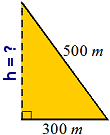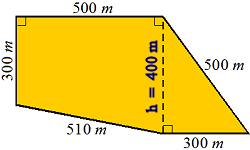can consider it a notable achievement. It isn't exactly the be-all, end-all of mathematical accomplishments but it is quite a fundamental standard by which anyone's quantitative literacy is benchmarked
|
test or evaluate performance for purposes of establishing a comparative score |
|---|
|
marked by complexity and richness of detail; developed or executed with care and in minute detail; intricate or fancy |
|---|
Find the Area, in hectares (ha), for the property shown in the illustration. Hint: use the equivalence that 1 ha = 10,000 m².

vertical line (i.e., the height of the right triangle) is unknown, which is also a key dimension to the trapezoid. Thus, the first calculation will be to determine this quantity (as it is needed in order for us to obtain the Area for either of the two simple figures) via Pythagoras:
 |
A somewhat mysterious Greek mathematician, who lived circa 500 B.C.E., and whose name is accredited to the infamous Pythagorean Theorem (a² + b² = c²). |

| h | ² | + | ( | 300 m | ) | ² | = | ( | 500 m | ) | ² | ||
| h | ² | + | 90,000 m² | = | 250,000 m² | ||||||||
| h | ² | = | 250,000 m² | - | 90,000 m² | ||||||||
| h | ² | = | 160,000 m² | ||||||||||
| h | = | √160,000 m² | |||||||||||
| h | = | 400 m | |||||||||||
